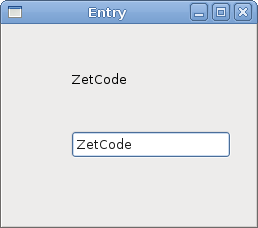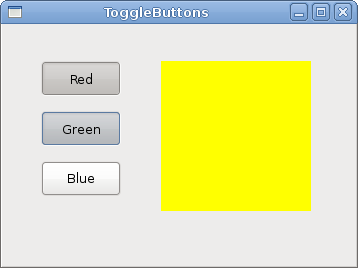Widgets II in GTK#
last modified October 18, 2023
In this part of the GTK# programming tutorial, we continue introducing GTK# widgets.
We cover the Entry widget, the Scale widget,
ToggleButton, and Calendar widget.
Entry
The Entry is a single line text entry field. This widget is used
to enter textual data.
using Gtk;
using System;
class SharpApp : Window {
Label label;
public SharpApp() : base("Entry")
{
SetDefaultSize(250, 200);
SetPosition(WindowPosition.Center);
BorderWidth = 7;
DeleteEvent += delegate { Application.Quit(); };
label = new Label("...");
Entry entry = new Entry();
entry.Changed += OnChanged;
Fixed fix = new Fixed();
fix.Put(entry, 60, 100);
fix.Put(label, 60, 40);
Add(fix);
ShowAll();
}
void OnChanged(object sender, EventArgs args)
{
Entry entry = (Entry) sender;
label.Text = entry.Text;
}
public static void Main()
{
Application.Init();
new SharpApp();
Application.Run();
}
}
This example shows an entry widget and a label. The text that we key in the entry is displayed immediately in the label control.
Entry entry = new Entry();
Entry widget is created.
entry.Changed += OnChanged;
If the text in the Entry widget is changed,
we call the OnChanged method.
void OnChanged(object sender, EventArgs args)
{
Entry entry = (Entry) sender;
label.Text = entry.Text;
}
We get the text from the Entry widget and
set it to the label.

Scale
The Scale is a widget that lets the user graphically
select a value by sliding a knob within a bounded interval. Our
example will show a volume control.
using Gtk;
using System;
class SharpApp : Window {
Gdk.Pixbuf mute, min, med, max;
Image image;
public SharpApp() : base("Scale")
{
SetDefaultSize(260, 150);
SetPosition(WindowPosition.Center);
DeleteEvent += delegate { Application.Quit(); };
HScale scale = new HScale(0, 100, 1);
scale.SetSizeRequest(160, 35);
scale.ValueChanged += OnChanged;
LoadPixbufs();
image = new Image(mute);
Fixed fix = new Fixed();
fix.Put(scale, 20, 40);
fix.Put(image, 219, 50);
Add(fix);
ShowAll();
}
void LoadPixbufs()
{
try {
mute = new Gdk.Pixbuf("mute.png");
min = new Gdk.Pixbuf("min.png");
med = new Gdk.Pixbuf("med.png");
max = new Gdk.Pixbuf("max.png");
} catch {
Console.WriteLine("Error reading Pixbufs");
Environment.Exit(1);
}
}
void OnChanged(object obj, EventArgs args)
{
HScale scale = (HScale) obj;
double val = scale.Value;
if (val == 0) {
image.Pixbuf = mute;
} else if (val > 0 && val < 30) {
image.Pixbuf = min;
} else if (val > 30 && val < 80) {
image.Pixbuf = med;
} else {
image.Pixbuf = max;
}
}
public static void Main()
{
Application.Init();
new SharpApp();
Application.Run();
}
}
In the example above, we have HScale and
Image widgets. By dragging the scale we change the image
on the Image widget.
HScale scale = new HScale(0, 100, 1);
HScale widget is created. The parameters
are lower boundary, upper boundary and step.
HScale scale = (HScale) obj; double val = scale.Value;
In the OnChange method we obtain the
value of the scale widget.
if (val == 0) {
image.Pixbuf = mute;
} else if (val > 0 && val <= 30) {
image.Pixbuf = min;
} else if (val > 30 && val < 80) {
image.Pixbuf = med;
} else {
image.Pixbuf = max;
}
Depending on the obtained value, we change the picture in the image widget.

ToggleButton
ToggleButton is a button that has two states: pressed and not pressed.
You toggle between these two states by clicking on it. There are situations where
this functionality fits well.
using Gtk;
using System;
class SharpApp : Window {
DrawingArea darea;
Gdk.Color col;
public SharpApp() : base("ToggleButtons")
{
col = new Gdk.Color(0, 0, 0);
SetDefaultSize(350, 240);
SetPosition(WindowPosition.Center);
BorderWidth = 7;
DeleteEvent += delegate { Application.Quit(); };
ToggleButton red = new ToggleButton("Red");
red.SetSizeRequest(80, 35);
red.Clicked += OnRed;
ToggleButton green = new ToggleButton("Green");
green.SetSizeRequest(80, 35);
green.Clicked += OnGreen;
ToggleButton blue = new ToggleButton("Blue");
blue.SetSizeRequest(80, 35);
blue.Clicked += OnBlue;
darea = new DrawingArea();
darea.SetSizeRequest(150, 150);
darea.ModifyBg(StateType.Normal, col);
Fixed fix = new Fixed();
fix.Put(red, 30, 30);
fix.Put(green, 30, 80);
fix.Put(blue, 30, 130);
fix.Put(darea, 150, 30);
Add(fix);
ShowAll();
}
void OnRed(object sender, EventArgs args)
{
ToggleButton tb = (ToggleButton) sender;
if (tb.Active) {
col.Red = 65535;
} else {
col.Red = 0;
}
darea.ModifyBg(StateType.Normal, col);
}
void OnGreen(object sender, EventArgs args)
{
ToggleButton tb = (ToggleButton) sender;
if (tb.Active) {
col.Green = 65535;
} else {
col.Green = 0;
}
darea.ModifyBg(StateType.Normal, col);
}
void OnBlue(object sender, EventArgs args)
{
ToggleButton tb = (ToggleButton) sender;
if (tb.Active) {
col.Blue = 65535;
} else {
col.Blue = 0;
}
darea.ModifyBg(StateType.Normal, col);
}
public static void Main()
{
Application.Init();
new SharpApp();
Application.Run();
}
}
In our example, we show three toggle buttons and a DrawingArea.
We set the background colour of the area to black. The toggle buttons will
toggle the red, green and blue parts of the colour value. The background
colour will depend on which toggle buttons we have pressed.
col = new Gdk.Color(0, 0, 0);
This is the colour value that is going to be updated with the toggle buttons.
ToggleButton red = new ToggleButton("Red");
red.SetSizeRequest(80, 35);
red.Clicked += OnRed;
The ToggleButton widget is created. We set its size
to 80x35 pixels. Each of the toggle buttons has its own handler method.
darea = new DrawingArea(); darea.SetSizeRequest(150, 150); darea.ModifyBg(StateType.Normal, col);
The DrawingArea widget is the widget that
displays the colour, mixed by the toggle buttons. At start, it shows
black colour.
if (tb.Active) {
col.Red = 65535;
} else {
col.Red = 0;
}
We update the red part of the colour according to the
value of the Active property.
darea.ModifyBg(StateType.Normal, col);
We update the colour of the DrawingArea widget.

Calendar
Our final widget is the Calendar widget. It is used to
work with dates.
using Gtk;
using System;
class SharpApp : Window {
private Label label;
public SharpApp() : base("Calendar")
{
SetDefaultSize(300, 270);
SetPosition(WindowPosition.Center);
DeleteEvent += delegate { Application.Quit(); };
label = new Label("...");
Calendar calendar = new Calendar();
calendar.DaySelected += OnDaySelected;
Fixed fix = new Fixed();
fix.Put(calendar, 20, 20);
fix.Put(label, 40, 230);
Add(fix);
ShowAll();
}
void OnDaySelected(object sender, EventArgs args)
{
Calendar cal = (Calendar) sender;
label.Text = cal.Month + 1 + "/" + cal.Day + "/" + cal.Year;
}
public static void Main()
{
Application.Init();
new SharpApp();
Application.Run();
}
}
We have the Calendar widget and a Label.
The selected day from the calendar is shown in the label.
Calendar calendar = new Calendar();
Calendar widget is created.
Calendar cal = (Calendar) sender; label.Text = cal.Month + 1 + "/" + cal.Day + "/" + cal.Year;
In the OnDaySelected method we get the referece
to the Calendar widget, and update the label to
the currently selected date.

In this chapter, we finished talking about the GTK# widgets.